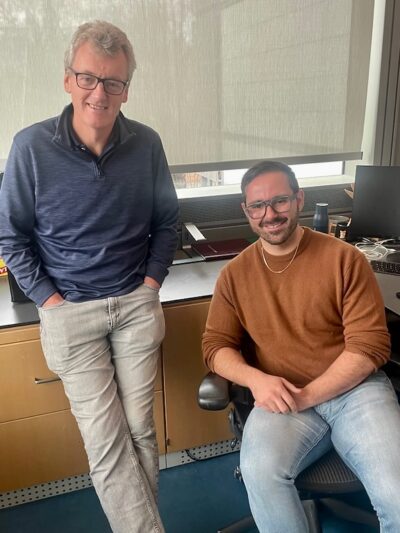MacMillan Group intros new strategy generalizing C–H alkylations with plug-and-play precision
Expanding on their investigations into reactive radicals that can be used for generalizing chemical reactions, researchers in the MacMillan Lab have published a novel strategy for the selective coupling of differently hybridized radical species. They call it Dynamic Orbital Selection, and they believe it will provide pharmaceutical companies with a new tool to generate “plug-and-play” molecules to develop drugs and get them quickly and efficiently into clinical trials.
PAPER: “Generalizing arene C-H alkylations by radical-radical cross coupling.”
JOURNAL: Nature.
AUTHORS: Johannes Grosskopf, Chawanansaya Gopatta, Robert Martin, Alexander Haseloer, David MacMillan, and the Merck Center for Catalysis.
WHAT IT IS: This new synthetic strategy allows chemists to take broadly available, basic sub-units in organic chemistry and join them together like Lego pieces to build more complex molecules with a novel strategy that has little precedent in theory and none in practice. Researchers bypass the traditional Friedel-Crafts alkylation, with its poor functional group tolerance and “forcing conditions” that limit applicability, to unlock alkylation of native aryl C-H bonds.

Graphic showing how the lab uses dynamic orbital selection to unlock alkylation of native aryl C–H bonds.
HOW THEY DID IT: The work relies on the formation of two distinct radical species differentiated by a copper-based catalyst, based on their respective binding properties. Researchers demonstrate a general, highly modular reaction for the direct alkylation of native arene-H bonds using benign, ubiquitous alcohols and carboxylic acids as the alkylating agents, and eliminating the need for a pre-installed functional handle.
Their solution enables a vast expansion of accessible chemical space.
COMMENT FROM JOHANNES GROSSKOPF, LEAD AUTHOR AND POSTDOC IN THE MACMILLAN LAB: “The whole idea of the proposal was to overcome this problem with radical chemistry. That’s why there’s a whole part of the paper just devoted to functionalizations of drug molecules and late-stage intermediates, because we can show that without the need for toxic materials we can get all of these reactions going. And we can make products within one or two steps, where before you’d need like 10 or 12.
“So, we combine two things in this paper. The first is that we have a new approach to coupling radicals. We call it dynamic orbital selection because upon light irradiation our system contains copper and radical species that form a dynamic interaction network—each engaging differently, which leads them to sort one another selectively. We funnel our whole system through this equilibrium, or this network of reactions, into our product. We don’t need ligands. We just add chlorides and acetates and let the copper sort itself out.
“The second thing is the broad applicability. In the supporting information to this paper, I think we have around 90 to 100 compounds, all differently substituted with different electronic properties and abilities that work well that can be used by the broad community, and especially by medicinal chemists.
“We wanted a method that’s reliable and has functional group tolerance so that we can functionalize highly specific molecules in a really late stage of their development. And that’s what we’ve done.”

David MacMillan, the James S. McDonnell Distinguished University Professor of Chemistry; and Johannes Grosskopf, postdoc and lead author on the paper.
COMMENT FROM P.I. DAVID MACMILLAN: “This is the thing that we love about chemistry: it reveals its secrets very slowly. We didn’t know what this was going to provide when we got started. Once we started testing it, it turns out you could use this methodology for so many different things. And so those secrets were brought out along the way.
“My skepticism with respect to the generality was defeated by chemistry’s mystique at being able to demonstrate things you could never imagine, which is why we love doing chemistry. There are all these things in science you just don’t know are there. But then once you start to look and investigate, you find things just sitting there waiting for you. It’s like a gift.”
FUNDING: Research reported in this work was supported in part by the National Institute for General Medical Sciences of the National Institute of Health (R35GM134897), the Office of Naval Research (N000142112138) the Deutsche Akademie der Naturforscher Leopoldina (LPDS 2023-03), the National Science Foundation (Grant No. 2316541), the German Research Foundation (HA 9945/1) and gifts from Merck, Pfizer, Janssen, Bristol-Myers Squibb, Genentech, and Genmab.
